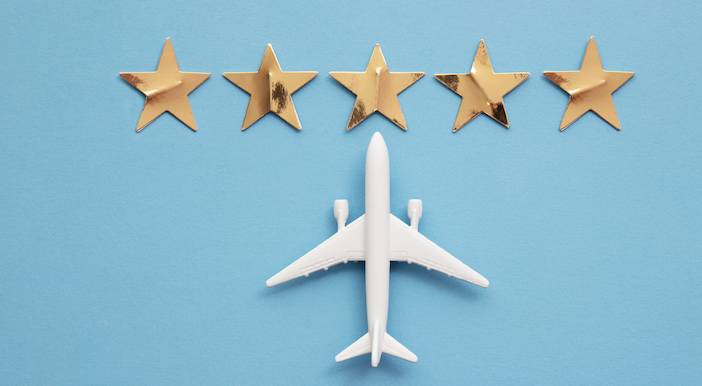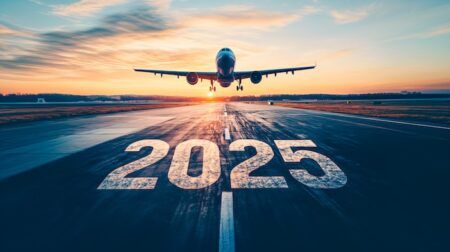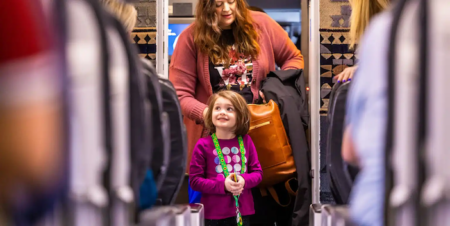Brand reputation is more important than ever in today’s digital, interconnected age. The ability for information to spread online (accurate or not), is becoming unstoppable. Consequently, a company’s actions, whether they involve harmful, unethical, or unsustainable practices, or proactive measures such as taking bold steps to protect the planet, or unveiling innovations to enhance services, hold significant weight.
And often, the perception of these actions is even more important. The power and influence of both traditional media and social media have significantly amplified the impact of both positive and negative information, shaping public perception in real-time.
As airlines are responsible for the safe transportation of millions of passengers daily, trust and reliability are paramount. Therefore, for the airline industry, maintaining a solid and positive reputation couldn’t be more crucial.
While safety concerns underpin much of the consumer perceptions of airlines, reputation in this sector is a complex equation. And as the aviation industry continues to grow and evolve, several additional criteria are creeping into the equation. Notably, sustainability and accessibility are growing in importance.
In an era where environmental consciousness and inclusive travel are paramount, airlines are increasingly judged on their efforts to reduce their carbon footprint and ensure equitable access for all passengers. An airline’s products and services have the most influence on passengers.
Aircraft Interiors Expo (AIX) has partnered with Carma, a media analysis and intelligence service provider, to investigate how cabin design and passenger experience can impact an airline’s reputation.
Methodology
 Carma employs a comprehensive approach to gauging reputation, analysing media coverage, social media activity, and audience perception through six pillars: products/services, sustainability, conduct, vision, performance, and culture.
Carma employs a comprehensive approach to gauging reputation, analysing media coverage, social media activity, and audience perception through six pillars: products/services, sustainability, conduct, vision, performance, and culture.
A Reputation Score is calculated separately for traditional media, social media and audience research, and then combined. The score for each component is composed by weighting the presence of the six pillars with the tone and volume of coverage/respondents, which is then weighted by the importance of each pillar to the audience (based on audience research).
The research also provides insights into how reputation impacts purchasing decisions differently across various regions. For instance, in the Kingdom of Saudi Arabia (KSA) and United Arab Emirates (UAE), reputation is a strong driver of airline choice, while in Asia, purchase decisions are more complex. In the UK, reputation and purchasing decisions are often more separate considerations.
For the purpose of this report, stories and posts have been tracked regarding 12 airlines across 8 different countries, over the course of one year (2024). In total, the analysis considered 55,267 articles and 1,014,058 social media posts.
Full breakdown of sources:
Sources: Online, social media
Time period: 1st January 2024 – 31st December 2024
Areas tracked: Hong Kong, Qatar, Saudi Arabia, Singapore, United Arab Emirates, United Kingdom, United States (USA), Malaysia
Airlines tracked: British Airways, Cathay Pacific, Emirates Airline, Etihad Airlines, KLM, Lufthansa, Malaysian Airlines, Qatar Airways, Saudia, Singapore Airlines, Turkish Airlines, Virgin Atlantic
Total articles in dataset: 55,267
Total social media posts in dataset: 1,014,058
Driving airline reputation
So what factors are truly driving reputation in the airline industry? Carma has created a unique methodology to track reputation, based on its six key pillars:
Products and Services: Anything related to the airline’s customer offering, such as quality, reliability and customer service.
Culture: Anything related to the airline’s organisational culture, such as employee treatment, health & safety, diversity & inclusion.
Sustainability: Anything related to the airline’s sustainability actions including community engagement, environmental impact, and charitable endeavours.
Conduct: Anything related to the airline’s behaviour and conduct, such as authenticity, transparency, compliance, and ethical behaviour.
Performance: Anything related to the airline’s business performance, such as consistency, investment potential, and financial results.
Vision: Anything related to the airline’s direction and vision of the future, such as innovation, value proposition, and expertise.
Analysis of the perceptions of 1,534 people based in the UK, UAE, KSA, Malaysia, Hong Kong and Singapore, found that Products and Services was the most influential factor in shaping people’s perception of an airline. Similarly, the study showed that Products and Services was also the biggest driver of coverage, accounting for 70% of traditional media and 65% of social media posts.
Carma also found that Products and Services was a more influential category than Conduct, Performance or Culture. This suggests that by continuing to offer new and innovative services onboard, airlines can maintain or even improve their reputation, helping to influence purchasing decisions.
Regional variations
Carma also found notable variations in how different regions value reputational factors. Notably, in the UK, airline reputation scores were not found to directly align with the volume of media coverage. For instance, Emirates received the best overall score in the region, despite a relatively low amount of traditional media coverage.
Whereas British Airways, despite having the lowest reputation score, was rated the highest in terms of likelihood of usage. This indicates the need for a greater and more positive exposure of BA’s products and services in the media to strengthen its brand reputation.

Meanwhile, in Asia, Singapore Airlines stood out from the pack as the most reputable airline. Notably, the airline scored highly in the Products and Services category, reinforcing the importance of this pillar. However, reputation again wasn’t found to be the most important factor in terms of likelihood of usage. Despite being rated as the most reputable airline, Singapore Airlines was only rated third for likelihood of usage.
Finally, in the UAE and KSA, Carma’s report found that the Middle East-based airlines received the most positivity from the media and audiences. Unsurprisingly, Emirates led the way with the highest reputation score, but was closely followed by Etihad Airways, Qatar Airways, and Saudia. Similarly to the other regions, the top airlines in terms of reputation also scored highly in Products and Services.
Given the importance of Products and Services on airline reputation score, investing in new and innovative onboard experiences will be essential for airlines moving forward. For airlines looking to bolster their interior products, services and onboard offering, Aircraft Interiors Expo (AIX) remains the event to attend.
As the world’s leading platform for airlines and cabin interiors professionals, AIX showcases products from all aspects of the cabin, from lighting, seating, galley equipment, and LEDs, to cabin management systems, IFEC hardware, and communications.

Aviation’s sustainability challenge: navigating expectations
Many consumers are aware of aviation’s impact on the environment, and look to fly with airlines that prioritise making sustainable choices and continually improvements. A recent survey from an international aerospace company found that 65% of respondents believe it is time for sustainable air travel. The survey found that 70% of all respondents from across the UK, US, France and Germany are concerned about the role of aviation in climate change.
But what does the media landscape look like when it comes to airline sustainability news? Over the course of 2024, Carma (which analysed over 55,000 articles in the mainstream media) identified six key spikes in activity.
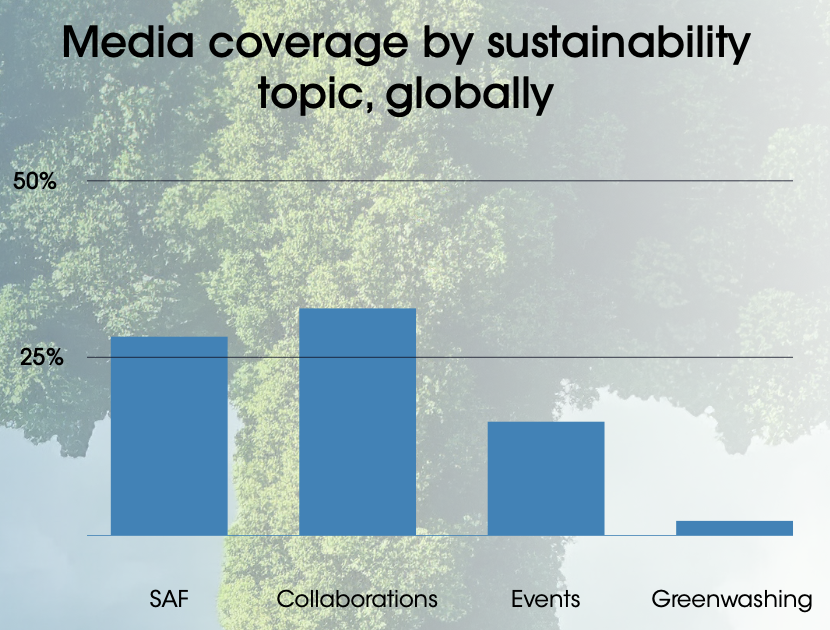
The data showed that sustainable aviation fuel (SAF) dominated much of the media coverage when it comes to sustainable aviation stories. However, in reality, the landscape for this is much larger. Though SAF is certainly part of the narrative, many airlines are taking significant steps to reduce their carbon emissions and minimise their impact on the environment through sustainable aircraft interiors.
The coverage suggests that there is a huge window of opportunity for airlines to gain a competitive advantage by promoting and generating wider awareness of other sustainability initiatives, whether that be the introduction of lightweight seating, or the use of more recycled materials on-board.
Key media moments in 2024:
09 April: Sustainability was listed as “one of the most pressing issues in aviation” ahead of the 2024 Future Aviation Forum.
03 June: The need to switch to sustainable aviation fuel was highlighted as a key cost to factor in for airlines as demand recovers from Covid-19.
25 June: There was a wave of coverage after Lufthansa, Europe’s biggest airline group, announced it would introduce a surcharge of up to €72 per flight in 2025 to cover the costs of switching to alternative fuels necessary to lower emissions.
07 August: Virgin Atlantic was the subject of significant (largely negative) media coverage after its fuel advert was banned by the Advertising Standards Authority (ASA), which ruled it to be “misleading”.
18 September: Climate technology firm, Air Company, announced that it had secured backing from aviation fuel supplier, Avfuel, in its latest funding round as it looks to convert carbon dioxide into more climate-friendly products.
31 October: There was a spike in news coverage when China-based airline, Xiamen Airlines won the APEX World-Class Airline award, and the company cited ‘Caring for the Earth’ as one of its three core pillars.
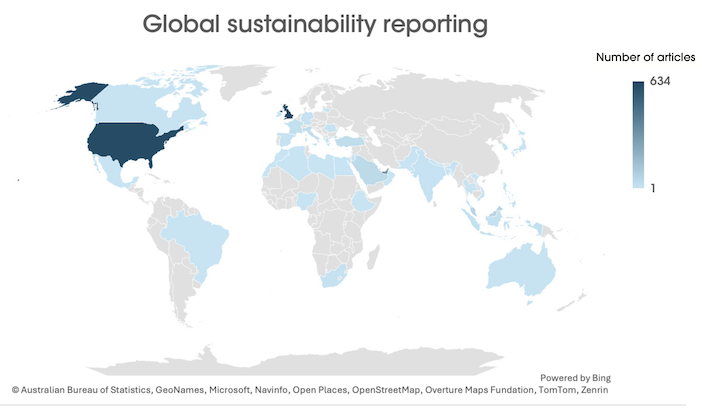
Now let’s take a closer look at the news coverage. Excluding sustainable aviation fuel, if we break down the coverage, we can see that:
- Collaborations were another significant driver of sustainability coverage, making up 32% of articles.
- Events were the focus of 16% of all sustainability articles.
- Greenwashing only accounted for 2% of all sustainability articles.
Additionally, if we examine the statistics for sentiment around sustainability news coverage overall, we can see that:
- Positive coverage accounted for 53%
- Neutral coverage accounted for 25%
- Negative coverage accounted for 22%
In terms of geographical distribution, Carma’s data showed that (out of the areas analysed) the top five countries for sustainability coverage included:
- UK coverage accounted for 37%
- US coverage accounted for 36%
- United Arab Emirates coverage accounted for 18%
- Singapore coverage accounted for 6%
- Malaysia coverage accounted for 4%
Looking at the news coverage in more detail, it is clear that partnerships were very effective at boosting sustainability messaging. Some of the most notable examples of stories in 2024 included:
24 January: Lufthansa Group chose Viasat to install the European Aviation Network (EAN) in-flight connectivity solution.
The articles specifically highlighted how the EAN allows Lufthansa Group to both save money and be more sustainable on its flights because of its ‘small, low weight, low-drag terminals’.
01 May: Turkish Airlines, Airbus and Rolls-Royce entered into a partnership for workforce and innovation.
01 October: Qatar Airways Group announced plans to acquire a minority 25% equity stake in Virgin Australia.
This is an interesting example as the focus isn’t solely on sustainability, but is linked to it largely by spokespeople quoted in the articles.
It is worth noting that in much of the partnership news, sustainability wasn’t the crux of the story. However, as explained above, the sustainability messaging was boosted through spokesperson quotes, indicating the importance of maximising these opportunities for airlines.
Greenwashing was a theme throughout the year, but it did not penetrate news coverage all that widely, appearing in only 2% of all sustainability coverage. Notably, the stories did translate into social media activity in a way other sustainability topics did not. A key example of this was an announcement from the EU it would be investigating 20 carriers for potential ‘greenwashing’. Data from Carma also indicated that the US is more engaged with the topic of greenwashing than any other country.
Exploring social media
When looking into social media activity throughout 2024, there appears to be very little crossover between the top news coverage and social media posts. The lack of continuity between the platforms suggests a potential window of opportunity for airlines to drive further traction in sharing their sustainability stories on social media. From a reputation perspective, there is more that could be done to drive these new stories and translate them into positive conversations on social media.
Spotlighting sustainable cabin interiors
Despite a complex media landscape, airlines across the globe are increasingly investing in a variety of products, strategies and initiatives which are helping to reduce their environmental impact. However, given the data at hand, it seems that many of the top stories are consistently neglecting to mention some of the most innovative strategies for reducing carbon emissions inside the cabin. Sustainable aircraft interiors are a particularly un-reported area in the media.
Some of the most common themes, products and strategies being employed in sustainable aircraft interiors include lightweighting. For airlines, this involves the process of reducing the overall weight of the aircraft, its components and materials, primarily through the use of lighter materials and optimised designs to improve fuel efficiency and reduce emissions. There are a number of different methods of lightweighting, which include lighter weight paint, aircraft seating, galleys, and flooring.
Despite the topic of sustainable aviation gaining significant traction in the media, it is clear that an important segment within sustainability – cabin interiors – is going underrepresented in the news. The aircraft interiors industry is tackling the challenge of sustainability in a variety of ways, which are not being reported on in any great detail in the mainstream national or business media. However, these solutions are being invested in, and they are helping to drive the future of aviation through the medium of sustainable interiors.
Accessibility in aviation: a growing imperative
For airlines, sustainability is not the only ethical concern that they must address. In recent years, discussions around inclusivity and accessibility in aviation have significantly intensified. This growing focus is driven by a greater awareness of the diverse needs of passengers and increasing pressure from a range of industry stakeholders, including affected passengers and their advocates.
Slowly but surely, this pressure is leading to change within the industry. This growing focus also aligns with the importance of the Conduct pillar in airline reputation – the second most important factor – as it underlines the significance of how airlines manage their relationships with passengers. Accessibility accounts for 1.2% of airline coverage, and 2% of social media posts.
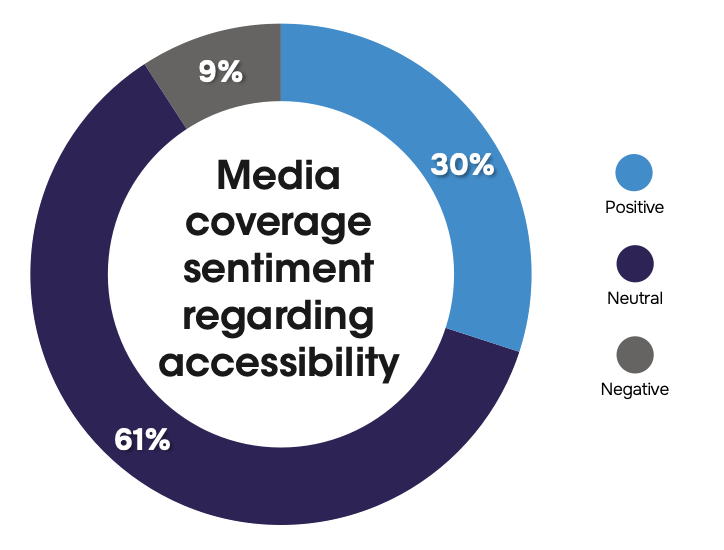
Airlines are increasingly recognising that accessibility is a crucial factor, intrinsically linked to their conduct. There is a growing demand for airlines to adapt and innovate to meet the evolving expectations of all passengers, including those with physical disabilities, limited mobility, non-visible disabilities, and neurodiverse differences. This is driving investment in training, infrastructure and technology, to ensure a more equitable and comfortable travel experience, demonstrating a commitment to treating all passengers with fairness and respect.
But what does the media landscape look like around accessibility in aviation? Exploring the data for sentiment around accessibility news coverage, we can see that differs significantly from sustainability, with the vast majority of articles having a neutral sentiment:
- Neutral coverage accounted for 61%
- Positive coverage accounted for 30%
- Negative coverage accounted for 9%
In terms of geographical distribution, Carma’s data found that (out of the countries analysed) the top five countries for accessibility coverage included:
- UK coverage accounted for 43%
- US coverage accounted for 37%
- United Arab Emirates coverage accounted for 11%
- French coverage accounted for 6%
- Saudi Arabian coverage accounted for 3%
According to data from the Carma platform, the biggest spike in reporting was on the 26th September, as major airline, Virgin Atlantic, announced it would be stepping up its efforts to help deaf and hard-of-hearing travellers, with initiatives including special training for more of its crew.
The story was widely reported across UK publications – with 197 total articles on this in a single day. An important factor in the widespread coverage can likely be attributed to the airline partnering with deaf Gladiators star Jodie Ounsley, and deaf twins and content creators, Hermon and Heroda Berhane.
This collaboration not only put a human face to the airline’s accessibility initiatives, but also amplified the message through the reach and influence of these popular public figures, demonstrating the positive impact of working closely with disabled people, and ensuring greater visibility for the story.
While Virgin’s story gained the greatest traction in the media, there were a number of other stories less widely reported, which shared important updates on the state of accessibility in the airline industry. It is worth noting that the stories around airline accessibility for passengers with physical disabilities or limited mobility were generally more widely covered than the stories discussing accessible changes for neurodiverse passengers or those with invisible disabilities. Another point to observe is that these stories were picked up largely by the aviation and aircraft interiors trade media, as opposed to the national or business media.
Additional coverage on the topic of accessibility included:
The news that Delta Flight Products (DFP), in collaboration with AirForAll – a consortium of design and disability advocate organisations based in the UK – announced the launch of several new accessibility-focus products for the airline industry; including seating systems that allow users to remain in their own wheelchair for the entire journey, and an accessible toilet that accommodates an onboard wheelchair and up to two attendants.
United Airlines announced its collaboration with the United Spinal Association. The partnership was focused on improving the travel experience for customers with disabilities. The airline will be working together with United Spinal to explore future solutions and collaborate with its community of experts to harness their valuable feedback and help better meet the specific needs of customers who use wheelchairs.
In January 2025, Emirates announced it was set to be ‘the world’s first Autism Certified Airline’. Formally awarded by the International Board of Credentialing and Continuing Education Standards (IBCCES), in practice this means over 30,000 staff will be undergoing specialised autism and sensory awareness training. The airline will also be introducing ‘sensory guides’ and sensory products for neurodiverse passengers.
At the end of 2024, Alaska Airlines reported its improved practices for enhanced accessibility for travellers. The airline’s Disability Office teamed up with the Autism Society and port authorities to host a disability practice flight in Portland. The event gave guests with disabilities the chance to practice everything from navigating the airport, to going through security and even simulating a flight.
Reports of crews damaging passengers’ wheelchairs, and other similar issues, was another key theme in accessibility coverage. Again, it is worth noting that these stories were covered by UK national media, as opposed to trade titles. For instance:
20 February: Furious passenger blasts American Airlines and Delta after TWO wheelchairs were damaged and destroyed during separate trips in the same year.
01 May: ‘Degraded’ wheelchair user, 15, forced to shuffle up plane stairs and British Airways lost specialist chair.
29 September: Disabled traveller left ‘housebound’ for months after airline error.
04 December: Gatwick: Holiday ‘ruined’ after wheelchair broke on EasyJet plane.
Notably, Paralyzed Veterans of America’s response to a US Department of Transportation fine against American Airlines for its “unsafe and undignified treatment of passengers with disabilities who use mobility devices” accounted for 81% of the negative news coverage on this topic.
Other incidents also garnered significant coverage. In April, Southwest Airlines received substantial attention for poorly handling athletes’ wheelchairs on flights. The issue stemmed from a lack of communication, leading to the wheelchairs being disassembled despite the passengers’ requests, and then being presented to them in pieces at the end of the flight.
Notably, the coverage around wheelchairs specifically, as opposed to general accessibility articles, was far more negative than the average data set. For social media articles mentioning airlines and wheelchairs, the sentiment was as follows:
- Negative coverage accounted for 49%
- Neutral coverage accounted for 27%
- Positive coverage accounted for 24%
Meanwhile, the majority of the corresponding news coverage mentioning wheelchairs was neutral, due to comments from spokespeople balancing out the overall sentiment of the articles. For example, in the case of Southwest Airlines, when the airline was accused of poorly handling athletes’ wheelchairs, the company’s statement effectively denied the charge.
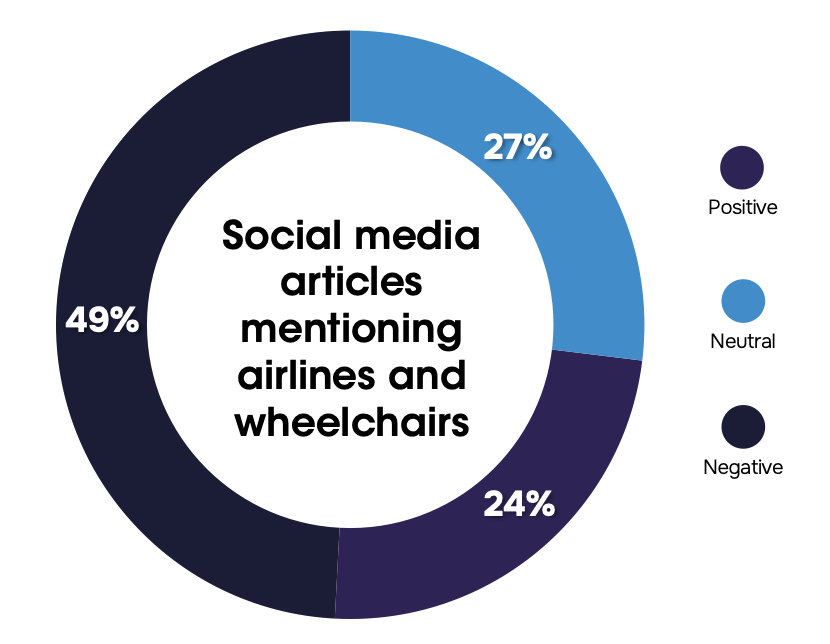
While social media coverage of the incident may have been negative, the inclusion of the airline’s response in news articles contributed to a more neutral sentiment overall. This demonstrates how airline communication can influence the tone of media reports, even when the initial incident generates negative public reaction.
But what does all this media coverage really tell us? While in comparison to other topics, accessibility isn’t proving to have cut through the ‘noise’ of the media in the same way, it seems that the impact of a negative story – particularly when discussed on social media – can attract significant attention and potentially be hugely impactful to airline reputation.
When faced with negative accessibility coverage, airlines need to do more than just react. The data indicates that a crucial element of effective reputation management is proactively ensuring the inclusion of company spokespeople in media reports. This allows airlines to actively participate in shaping the narrative.
Therefore, airlines should adopt a proactive communication strategy that prioritises the inclusion of their spokespeople in accessibility-related reporting. By providing spokespeople to offer context, address concerns, and articulate the airline’s position, they can exert greater control over the narrative and mitigate the potential damage of negative coverage.
Maksim Jurkov, head of design at aviation innovator, J&C Aero, explains that when it comes to accessibility, regulations play an important role. He highlights the ‘FAA DOT requirements (14 CFR 382.65)’, which demand “Non-discrimination on the basis of disability in air travel” and that “the industry needs to transport persons with reduced mobility (PRM) while maintaining a reasonable level of accessibility during the flight phase.”
He adds, “The key industry players are actively working on accessibility for both linefit and retrofit programmes. Accessibility for persons with limitations on an aeroplane is a must, not an option, as it ensures safety, dignity, and equal opportunity for all travellers – for example, having accessible restrooms and boarding assistance allows everyone to travel independently and comfortably. Without it, people are unfairly excluded and face unnecessary risks or barriers.”
While regulations are essential, accessibility in aircraft interiors is more than just a requirement. It is a commitment to all passengers and to creating a truly inclusive flying experience for everyone on board.
Conclusion
This review of airline reputation sets out a roadmap for airlines, identifying the six key pillars on which an airline reputation is built. By focusing on each pillar of the reputation methodology, and the strategic adjustments that can be made within each area, airlines can significantly improve their overall reputation.
It is clear that there will be opportunities to gain a competitive advantage over competitors by focusing on sustainability initiatives – particularly by implementing those in the cabin, as reputation is largely driven by the Products and Services pillar.
By investing in innovative solutions that transform the cabin, airlines will be able to further strengthen their reputation, not only through products and service offerings, but through the creation of a collective vision which positions the airlines as leaders in responsible air travel.
Though accessibility is not an individual element within the six pillars of the ‘Reputation by Carma’ report, it does play an important role in the conduct pillar. Not to mention, as more and more accessible aircraft interior solutions enter the market, it’s becoming a growing priority for airlines.
There’s also an increasing amount of media coverage and social media discussion around the topic. By using the media to their advantage, airlines can improve their reputation through the spotlighting of accessible interiors solutions.
The data highlighted in this report illustrates an ecosystem of conversations around sustainability and accessibility in the traditional media and on social media. While neither topic may be dominating the media in the same way that some other aviation topics are, it is clear that the impact of these stories can be significant in affecting consumer views and perceptions.
Moving forward, airlines must recognise that sustainability and accessibility are about more than just compliance and instead are fundamental aspects of building trust and maintaining a positive reputation in an increasingly conscious and connected world.


